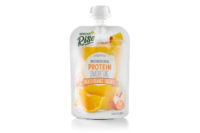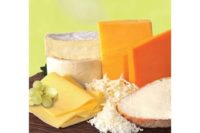Organic and natural food options are on the rise
Informed and engaged consumers seeking more natural and organic food options are driving growth for the organic/natural channels.












Thanks to the boost in supply of organic and natural products, including dairy, and increased demand for such products on the part of consumers, the organic and natural market continues to grow. Tied to this growth is a clean-label movement that doesn’t appear to be waning anytime soon.
The Washington, D.C.-based Agricultural Marketing Service (AMS) estimates that sales of total organic milk products for February 2018 were 205 million pounds, up 1% from February 2017. Sales were up 1.7% January through February this year compared to the same period in 2017. Sales of total organic whole-milk products for February 2018 reached 85 million pounds, up 10.9% compared to February last year, AMS reported.
While overall milk consumption is decreasing, organic milk is on the rise, according to “2018 U.S. Beverage Market Outlook,” a report from the Packaged Facts division of Rockville, Md.-based MarketResearch.com. But the report also noted there is a surplus of organic milk, as many small farmers switched to organic farming in recent years.
What’s driving growth?
Many processors said consumer preference is driving growth in the organic and natural channels.
“Consumers increasingly recognize the link between the way food is produced and their own food choices,” said Michael Neuwirth, senior director, external communication at Danone North America, White Plains, N.Y.
The growth also is attributed to a growing desire for transparency in food production, said Beth Deegan, director of product management, Applegate Farms LLC, Bridgewater Township, N.J. And organic and natural products typically offer more insight into standards and production practices, she added.
“Many consumers are interested in knowing where and how their food is raised,” noted Albert Straus, founder and CEO of Straus Family Creamery, Petaluma, Calif. “Organic is a respected model that has over decades developed standards of animal welfare and sustainable land practices based on farmers’ expertise. These standards include no use of synthetic hormones, no use of antibiotics, no use of synthetic fertilizers and no use of GMO’s.”
For many consumers, purchasing natural and organic is motivated by a desire for a “cleaner” product. But even more informed consumers believe it’s cleaner for the environment and better for the animals, too.
“In a consumer culture that’s currently drawn to products ... made by ‘nature’ rather than engineering, consumers see organic and natural foods and beverages as safer, higher-quality products,” said Helen Lundell, consultant, Hartman Retainer Services, The Hartman Group, Bellevue, Wash. “For more engaged consumers, organic and natural products are believed to be better for the world — people, animals and the environment.”
A combination of other factors is contributing to the growth in organic and natural products across our food system, Lundell explained.
“The biggest three factors are a decline in barriers to purchase, heightened perceptions consumers have of benefits to natural and organic products, and cultural changes that have led to organic and natural products holding more influence,” she said.
Each of these factors plays a part in a powerful feedback loop that will maintain growth for the foreseeable future, Lundell added.
“Fully 45% of U.S. consumers say they purchase organic products at least monthly now, compared with 27% a decade ago,” she noted.
Because traditional barriers to purchasing these products are diminishing, Lundell said organic and natural products are more widely available across categories, brands and retailers.
“At the same time, the price gap between natural/organic products and conventional is shrinking, largely through the growth in private label offerings,” she said. “Our recent study, ‘Organic & Natural 2018,’ found that 61% of consumers still say that the top barrier to purchasing organic products is price, but this number has dropped nine percentage points in the past two years.”
As more farmers, manufacturers and retailers see the value in offering organic and natural products to consumers, they increase supply and distribution, said Heather Engwall, director of marketing, Emmi Roth, Monroe, Wis.
“This makes it easier for consumers to find organic products while also driving down price points, making organic food more attainable,” Engwall added.
Challenges, benefits for processors
Navigating complex consumer trust issues in labeling and transparency could present challenges for processors getting into the natural and organic market, Lundell said.
“Iconic legacy brands, for example, can have a harder time convincing consumers of the authenticity of any changes made to the product or may even risk undermining consumer perceptions by ‘messing with’ a brand they love,” she said. “Of course, certification processes and logistical supply chain challenges can also represent major hurdles for manufacturers.”
Pete Kondrup, general manager of Westby Cooperative Creamery, Westby, Wis., noted other challenges processors could face: security of supplies and stability of costs and, in some cases, a shortened product shelf life due to the elimination of some production/process ingredients. He added that higher margins, brand preference, volume and share growth, and consumer loyalty are the pros for manufacturers getting into the organic/natural market.
“It costs more to raise animals humanely and get third-party certification for higher animal welfare, but we think it’s worth it,” Deegan said. “There are [also] some tools and ingredients in the conventional food tool box that are not available to us.
“We work around those challenges with a research and development team that works tirelessly to investigate the best natural and organic food production practices,” she added. “That may mean that our products don’t have as long of a shelf life as conventional products, but we think people interested in natural and organic foods understand and view that as a benefit, not a drawback.”
Deegan believes the best thing dairy processors and brands can do is lift the curtain and invite consumers in to learn more about their practices so they can see the difference themselves.
“The only way to build confidence and trust is to say what you do and do what you say – and show them,” she added.
Research shows that two out of three organic shoppers have been purchasing organic for less than a year, said the Organic Trade Association (OTA), Washington, D.C., in a written statement provided to Dairy Foods. Given this information, brands need to emphasize the basics about organic, OTA said.
“In the case of dairy, farmers are required to raise animals without the use of antibiotics or synthetic growth hormones. Plus, organic farmers must provide animals with 100% organic feed and access to pasture so they can freely roam about,” OTA said. “In fact, organic standards require that cows graze on grass for at least a third of their lives.”
Many manufacturers agree that being as transparent and honest as possible is important to gaining consumer trust.
“Consumers are craving transparency, and you should feel comfortable sharing all product information with them, especially when discussing something as intimate as the food they consume,” noted Jesse Merrill, CEO and co-founder of Good Culture cottage cheese.
Lundell pointed out that there is no single product attribute or callout that provides the “magic bullet” to change consumer perceptions of a brand.
“Changing ingredients to organic or switching out specific ingredients can be powerful, but without a brand or company narrative that unites a constellation of salient attributes, certifications, and positions, the changes may not hold weight,” she explained.
Be careful with ‘natural’
Many industry experts are guarded about using the word “natural” and similar product claims made on packaging.
“One word that we caution against using in descriptions of products is ‘natural.’ While the idea of ‘natural’ — real, whole, less processed — speaks strongly to consumer values, when they see it written on products, a common reaction is suspicion and further scrutiny,” Lundell explained. “It is better to show naturalness via a short ingredient list, whole ingredients, transparency about how the product was made and so forth than claim it.”
OTA added that “natural” and “clean label” are dubious terms.
“Only organic is backed by a stringent set of USDA guidelines that begins at the farm and maintains a product’s integrity throughout the supply chain
until it reaches the shopper. Reasons for farming organically are myriad and include better ... prices [and] holistic management of land and animals. For brands, organic is a strong differentiator backed by growing consumer demand,” OTA said.
Neal Gottlieb, founder and CEO of Three Twins Ice Cream, Petaluma, Calif., agrees that consumers have good reason to be skeptical of the term “all natural” because it’s not regulated and can be abused.
“I think that dairy processors need to do a lot more to point out the differences between so-called ‘conventional’ products ... and organic ones that better reflect how food has been for thousands of years, up until recent history,” Gottlieb said.
What’s new in organic/natural
A number of noteworthy organic and natural options hit the market in the past year, including cheese, milk, ice cream and cultured dairy offerings.
Applegate Farms, for example, introduced a natural cheese line under the Applegate Naturals brand. The non-GMO cheeses contain no added colors, preservatives or artificial ingredients. The cheese is available in six sliced varieties, including medium cheddar, American-style Colby and mozzarella; and three shredded varieties, including an Italian Blend.
“We’ve raised the bar on standards, including animal welfare practices, for our new natural cheese collection,” Deegan said. “Our cheese meets or exceeds the National Organic Program Organic Livestock and Poultry Practices rule recommendation.”
And Dutch Farms extended its milk portfolio with the launch of an organic line. The organic milk comes in half-gallon cartons and three varieties: skim, 2% and whole. The milk is currently available at retailers in the Chicago area.
Irvine, Calif.-based Good Culture, meanwhile, added two sweet organic flavors (mango and pineapple) to its line of cottage cheese in 2017. The cottage cheese is made with grass-fed milk and has probiotics.
Good Culture’s Jesse Merrill said that all of the company’s products are clean label and always have been. And the goal for the company is “to make real food products with simple ingredients more accessible.”
For its part, Westby Cooperative Creamery added an organic brand to its lineup. The line has four cultured dairy food products: 4% and 2% small curd cottage cheese in 16-ounce containers and sour cream and French Onion dairy dip in 12-ounce containers.
And Straus Family Creamery launched organic chocolate whole milk in August 2017. The whole milk comes from pasture-fed dairy cows. It’s sold in reusable glass 32-ounce bottles. The chocolate milk is made with only five ingredients: homogenized organic whole milk, organic cane sugar, Fair Trade Certified organic cocoa powder, organic vanilla extract and a lactase enzyme. With no emulsifiers or stabilizers such as carrageenan or gums, the chocolate milk has natural separation. This requires an extra shake or two of the bottle to blend the ingredients before drinking, the company said.
Like Westby Cooperative Creamery, Emmi Roth also recently added an organic line to its portfolio. The Roth Organics cheese line includes Grand Cru Original, Van Gogh Gouda, havarti and sharp cheddar cheeses.
Known for its organic ice cream, Three Twins Ice Cream launched an organic low-calorie ice cream pint line in February 2018 to address the reduced-sugar/calorie ice cream trend that’s been growing in popularity. Called Slim Twin, the line is available in seven flavors, including vanilla, mint chip, lemon cookie and chocolate. Three Twins’ Neal Gottlieb said Slim Twin is “the first and only organic offering in the better-for-you category.”
Looking for a reprint of this article?
From high-res PDFs to custom plaques, order your copy today!












